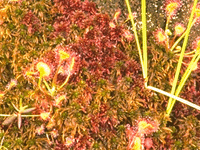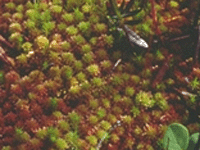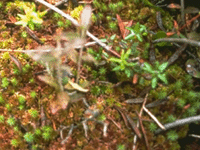| Sphagnum hummock and growth form
|
||
Peat moss growth forms |
||
|
Sphagnum moss grows very slowly. The most frequent growth formation that Sphagnum takes is "hummocks". There are many species of Sphagnum mosses. These species are frequently mixed in together in hummocks. The second most common formation of Sphagnum growth occurs on the beds of shallow lakes and ponds. If the conditions continue to be favourable to Sphagnum growth, these lakes and ponds can be filled by the moss, and the lakebed elevated above the water table. When this happen, Sphagnum usually starts growing in hummocks. In face, scientists have said that Burns Bog started developing out of shallow water, where different species of plants have grown. When the conditions became favourable for Sphagnum (peat) moss, peat accumulated and gave the Bog its present dome shape. |
|
 
|
|
Unlike many true moss species, peat moss (Sphagnum) usually does not grow on tree bark. Peat moss can survive very harsh conditions. A peat moss community very often contains various species of Sphagnum. It is very difficult to tell them apart except the Common red Sphagnum species, which stands out well because of its red colour. The Greater reindeer lichen (not shown here) is very likely to be mixed in with the Sphagnum too. The lichen, however, is more identifiable. It is more branchy, and it has a pale green. When you compare individual Sphagnum moss and Greater reindeer lichen, the difference is quite obvious. Other plants that often mix in with Sphagnum includes hardy true mosses, Labrador tea, Cotton-grass, and sundews (at very wet locations). |
|



|